deployment of the PLA Navy ships in the - Information Resource ...
deployment of the PLA Navy ships in the - Information Resource ...
deployment of the PLA Navy ships in the - Information Resource ...
Create successful ePaper yourself
Turn your PDF publications into a flip-book with our unique Google optimized e-Paper software.
FFFFFFFFFFFFFFFFFFF<br />
fundamental requirement around which <strong>the</strong> success<br />
<strong>of</strong> <strong>the</strong> comb<strong>in</strong>ed operations by IOR navies h<strong>in</strong>ges. It<br />
is <strong>the</strong>refore important to see that technical<br />
cooperation at all levels <strong>of</strong> ship design, build, operation<br />
and ma<strong>in</strong>tenance, is adequately addressed.<br />
Be<strong>in</strong>g far away from <strong>the</strong> base port for an<br />
extended time period would require open and<br />
unlimited access to <strong>the</strong> repair facilities <strong>of</strong> all <strong>the</strong> navies<br />
<strong>of</strong> IOR, <strong>in</strong>clud<strong>in</strong>g dry docks, to ensure that <strong>the</strong><br />
platforms dedicated to <strong>the</strong> comb<strong>in</strong>ed operations are<br />
sea worthy all <strong>the</strong> time. Demand for mach<strong>in</strong>ery and<br />
naval stores to take care <strong>of</strong> <strong>the</strong> exigencies aris<strong>in</strong>g at<br />
sea can be met only through standard codification.<br />
NEED FOR STANDARDS<br />
Interoperability and technical cooperation<br />
amongst <strong>the</strong> countries <strong>of</strong> IOR can be successful for <strong>the</strong><br />
comb<strong>in</strong>ed operations by ensur<strong>in</strong>g large scale<br />
standardisation <strong>in</strong> procedures, methods, design and<br />
build<strong>in</strong>g <strong>of</strong> <strong>ships</strong> and equipment. This will not only<br />
<strong>in</strong>crease <strong>the</strong> comb<strong>in</strong>ed operational effectiveness <strong>of</strong><br />
<strong>the</strong> naval forces to achieve <strong>the</strong> common goals, but also<br />
<strong>in</strong>crease overall efficiency <strong>in</strong> <strong>the</strong> use <strong>of</strong> available naval<br />
resources. This <strong>in</strong>cludes, among o<strong>the</strong>r th<strong>in</strong>gs,<br />
<strong>in</strong>creas<strong>in</strong>g co-operation and elim<strong>in</strong>at<strong>in</strong>g unnecessary<br />
duplication among IOR navies <strong>in</strong> research,<br />
development, production, procurement and support<br />
<strong>of</strong> defence systems and equipment. The collective<br />
naval capability <strong>the</strong>n enhances manifolds and carries<br />
additional political value as on outward<br />
demonstration <strong>of</strong> <strong>the</strong> cooperation and solidarity. This<br />
can be achieved only by <strong>the</strong> process <strong>of</strong> formulat<strong>in</strong>g,<br />
agree<strong>in</strong>g, implement<strong>in</strong>g and updat<strong>in</strong>g Standards for<br />
use with<strong>in</strong> IOR navies and can classified <strong>in</strong>to three ma<strong>in</strong><br />
groups as has been done by NATO countries [2] –<br />
Operational, Materiel and Adm<strong>in</strong>istration. It may be<br />
preferable to maximise <strong>the</strong> use <strong>of</strong> NATO standards to<br />
ensure worldwide supportability.<br />
It is a well known fact that Standards promote<br />
consistent quality, reliability and ma<strong>in</strong>ta<strong>in</strong>ability, whilst<br />
<strong>of</strong>fer<strong>in</strong>g <strong>the</strong> potential for variety control and economic<br />
production, by provid<strong>in</strong>g technical criteria accepted<br />
by consensus. They also encourage both <strong>in</strong>terchange<br />
ability and <strong>in</strong>teroperability, and rationalize processes<br />
and methods <strong>of</strong> operation mak<strong>in</strong>g communication<br />
and <strong>the</strong> exchange <strong>of</strong> materiel and services easier. Their<br />
use gives confidence to manufacturers and to users<br />
alike. Hence, <strong>the</strong> need to have common Standards,<br />
as early as possible, to make <strong>the</strong> IOR navies<br />
cooperation more robust.<br />
Levels <strong>of</strong> Standardisation. Standardized<br />
equipment belong<strong>in</strong>g to different navies may be<br />
compatible, <strong>in</strong>teroperable, <strong>in</strong>terchangeable or<br />
common. They may be none <strong>of</strong> <strong>the</strong>se, yet <strong>the</strong>ir<br />
components may be standardized, i.e.<br />
<strong>in</strong>terchangeable or common, an important<br />
advantage <strong>in</strong> ma<strong>in</strong>tenance and repair. In ascend<strong>in</strong>g<br />
order, <strong>the</strong> four levels <strong>of</strong> standardization has been<br />
def<strong>in</strong>ed by NATO as:<br />
• Compatibility is <strong>the</strong> capability <strong>of</strong> two or<br />
more items or components <strong>of</strong> equipment or<br />
materiel to exist or function <strong>in</strong> <strong>the</strong> same system<br />
or environment without mutual <strong>in</strong>terference;<br />
• Interoperability is <strong>the</strong> ability <strong>of</strong> systems,<br />
units or forces to provide services to, and accept<br />
services from, o<strong>the</strong>r systems, units or forces and<br />
to use <strong>the</strong> services so exchanged to enable<br />
<strong>the</strong>m to operate effectively toge<strong>the</strong>r;<br />
• Interchangeability is a condition which<br />
exists when two or more items possess such<br />
functional and physical characteristics as to be<br />
equivalent <strong>in</strong> performance and durability, and<br />
are capable <strong>of</strong> be<strong>in</strong>g exchanged one for <strong>the</strong><br />
o<strong>the</strong>r without alteration <strong>of</strong> <strong>the</strong> items <strong>the</strong>mselves,<br />
or <strong>of</strong> adjo<strong>in</strong><strong>in</strong>g items, except for adjustments,<br />
and without selection for fit and performance;<br />
• Commonality is a state achieved when<br />
groups <strong>of</strong> <strong>in</strong>dividuals, organizations or nations<br />
use common doctr<strong>in</strong>es, procedures or<br />
equipment.<br />
There is a school <strong>of</strong> thought that where it is<br />
possible to do so, maximum procurement should be<br />
<strong>of</strong> Commercial Off The Shelf (COTS) equipment for<br />
naval platforms. NATO and <strong>the</strong> America, Brita<strong>in</strong>,<br />
Canada and Australia (ABCA) Group <strong>of</strong> countries are<br />
<strong>the</strong>refore plac<strong>in</strong>g an <strong>in</strong>creased emphasis on <strong>the</strong> use<br />
<strong>of</strong> civil standards for military materiel standardization,<br />
a concept that is be<strong>in</strong>g implemented successfully.<br />
LIKELY CHALLENGES<br />
Networked Operations. The challenge that<br />
will confront all <strong>the</strong> Navies <strong>of</strong> IOR <strong>in</strong>itially would be <strong>in</strong><br />
FFFFFFFFF SEPTEMBER 2010<br />
FFFFFFFFF10




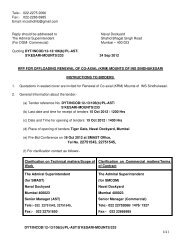
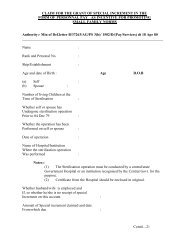
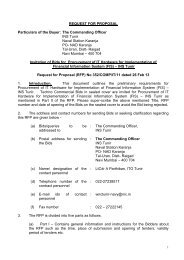
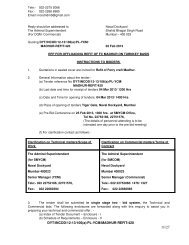
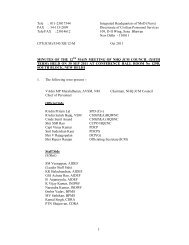
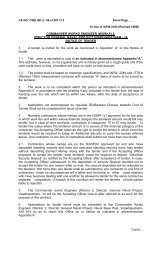

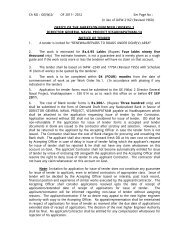
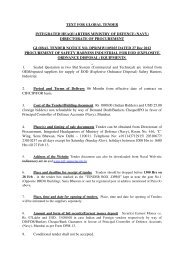
![DGNP[V] - Irfc-nausena.nic.in](https://img.yumpu.com/23509938/1/158x260/dgnpv-irfc-nausenanicin.jpg?quality=85)



